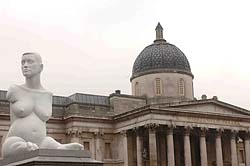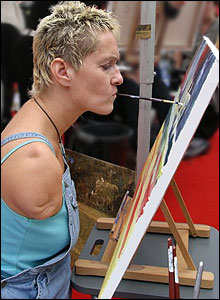The Eyes of the Beholder
 A statue in London's Trafalgar Square has stirred quite a controversy in England. Alongside the grand tributes to England's military might sits the attention-grabbing "Alison Lapper Pregnant," a 13-ton statue of an armless, nude, dwarf, great with child. As Dave Barry is want to say, "I am not making this up."
A statue in London's Trafalgar Square has stirred quite a controversy in England. Alongside the grand tributes to England's military might sits the attention-grabbing "Alison Lapper Pregnant," a 13-ton statue of an armless, nude, dwarf, great with child. As Dave Barry is want to say, "I am not making this up." Trafalgar Square features four plinthes for statues. The other three hold two English generals who fought in India and King George IV who went mad. The fourth plinth remained empty from its construction in the 1800s. The exhibit of Marc Quin's arresting work is part of a plan begun in 1998 to use the fourth plinth in the square for a revolving art show. Instead of placing one statue there for all time, works will be displayed in the prominent location before being removed to make room for a new exhibit.
 The subject of the work is the real life Alison Lapper who was born with no arms and shortened legs due to a chromosomal condition called Phocomelia. Abandoned by her mother, Alison was raised in a care home. Using her feet and mouth, Alison became a successful painter and photographer. Her own naked body has often been her subject.
The subject of the work is the real life Alison Lapper who was born with no arms and shortened legs due to a chromosomal condition called Phocomelia. Abandoned by her mother, Alison was raised in a care home. Using her feet and mouth, Alison became a successful painter and photographer. Her own naked body has often been her subject. In 2000, she beecame pregnant with her son, Parys, who she refers to as "her greatest work." In 2003, she was named to the prestigious Most Excellent Order of the Bristish Empire. Alison was featured with her son in the BBC series Child of Our Time, and she recently published an autobiography, My Life in My Hands. For the sculptor Quin, Alison emobodied a new kind of heroism.
 Some are strongly in favor of the display, while others are just as adamantly against it. Is the statue "a new model of female heroism" or does it serve "the purposes of honoring perverts and deviants." Both views have been claimed. While one might question the artist's decision to show Alison both nude and pregnant, is physical deformity a reason why an already noted member of British society should not be pictured in art?
Some are strongly in favor of the display, while others are just as adamantly against it. Is the statue "a new model of female heroism" or does it serve "the purposes of honoring perverts and deviants." Both views have been claimed. While one might question the artist's decision to show Alison both nude and pregnant, is physical deformity a reason why an already noted member of British society should not be pictured in art? Alison Lapper told London Disability Arts Forum, "As a disabled person, people patronise you and tell you how wonderful and brave you are. But I'm not. I'm just trying to live my life the best way I can."
Do we think our creator's hand slipped while making Alison Lapper? Or does God not love her as much Admiral Nelson who tops a nearby pillar. Artistic judgment aside, what do we think of showing a disabled person in such a prominent location, and what does that say about how we consider the disabled. Scripture would seem to be in favor of Alison Lapper being on the plinth as much as anyone else. The picture we get of Jesus from the Gospels is that he would have reached out to someone like Alison to bring her back into a society that might otherwise shun her. What do you think?
peace,
Frank+
The Rev. Frank Logue, Pastor + King of Peace Episcopal Church







0 Comments:
Post a Comment
<< Home